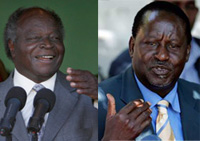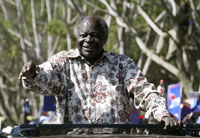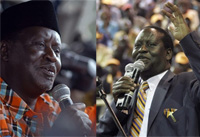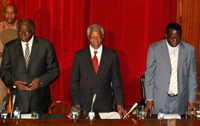Overview
Before and after the elections
by David Coffey
Article published on the 2008-04-30 Latest update 2008-05-13 13:53 TU
On 13 April 2008, Kenya’s president Mwai Kibaki named a grand coalition cabinet of 41 ministers, including the newly-created office of Prime Minister. After weeks of ethnic violence and political uncertainty that had gripped the country following December’s contraversial elections, Kibaki and Prime Minister-designate Raila Odinga agreed to share power.
In the run-up to Kenya’s fourth multi-party elections, alliances and splits within the ruling National Rainbow Coalition and the opposition Orange Democratic Movement prepared the terrain for December’s showdown.
In September Mwai Kibaki announced his intention to run for a second presidential term under a new alliance, the Party of National Unity (PNU).
Only a month before, the Orange Democratic Movement (ODM) split up. Stephen Kalonzo Musyoka led the break-away ODM-Kenya faction to the hustings. Raila Odinga remained as head of the main ODM, and the party faithful gave him their overwhelming endorsement as their presidential candidate on 1 September, 2007.
As election day approached, tensions flared into sporadic violence in Kenya’s western and Rift Valley regions, as political allegiances fuelled tribal divisions and polarised communities already suspicious of each other due to age-old land disputes.
Despite these confrontations, most Kenyans remained optimistic when casting their ballot.
PNU supporters, hoping for a continuation of Kenya’s economic boom, praised Mwai Kibaki’s tenure for achieving over six per cent annual economic growth. His credentials as a shrewd economist stand up to scrutiny, following a series of reforms and infra-structural investments that had steered the country away from near economic collapse pre-2003.
Followers of ODM’s Raila Odinga were enthusiastic in calling for change. Although Kibaki had presided over a robust economic turnaround, many Kenyans - 80 per cent of whom live in poiverty - felt sidelined by the business classes - and Kibaki’s inner-circle - as the benefits of the boom failed to trickle down. This sentiment, coupled with a series of financial scandals that directly implicated the president’s closest associates, led ODM supporters to decry Kibaki’s perceived cronyism and corruption.
Voting day
The polling booths opened at 7am on Thursday 27 December, with many of Kenya’s 14 million registered voters already waiting patiently in line since the early hours, to cast their ballots.
Although there were some delays among the 29,000 polling stations, the vote passed off peacefully, with a turnout of over 90 per cent in some constituencies.
Polls open
December 27: The first polling station opens in the town of Limuru, Central Province, the heartland of President Mwai Kibaki's Kikuyu tribe. RFI's David Coffey travelled there early on polling day to speak with voters before they cast their ballot.
Election day in Kibera
Thousands of residents of Nairobi's Kibera turned out to cast their ballots on December 27, but many complained of problems with mistaken voter registration rolls and delays in getting ballot boxes into the polling stations.
Over the following three days, despite initial tallies giving Raila Odinga a clear advantage in the race for State House, it was announced on Sunday, 30 December 2007, that Mwai Kibaki had won.
| Dossier:
In-depth look at events from polling day to protests |
The aftermath
What ensued was a wave of politically motivated ethnic violence as tribes united behind the ODM attacked families, communities and businesses associated with Kibaki’s dominant Kikuyu tribe.
The first displaced from Kibera
The riots that ensued following President Mwai Kibaki's election victory forced hundreds of families from their homes in Nairobi's Kibera slum. The IDP camp at Jamhuri stadium was one of the first to be set up outside the Kenyan capital following the first wave of post-election violence. RFI's David Coffey was one of the first foreign journalists on the scene.
From January through February 2008, as diplomatic efforts to resolve Kenya’s political crisis continued in Nairobi under the mediation of former UN Secretary General Koffi Annan, 1,500 people lost their lives and over 600,000 were displaced by inter-ethnic fighting.
Since April, the new power sharing government is now charged with healing the wounds that Kenyans inflicted on each other in the aftermath of December’s polls. Constitutional reform is paramount, but also the issue of land reform, which has been at the root of Kenya’s inter-tribal rivalries since independence in 1963.
As the dust has settled, the hard work has now begun in bringing communities together in regions that saw neighbour turn against neighbour in one of the bloodiest chapters in Kenya’s short history as an independent and stable nation.
Listen
A walk through Kibera
Life has always been hard for the residents of Nairobi's Kibera slum, even before riots and looting destroyed homes and businesses following Kibaki's election victory. RFI's David Coffey walked around Kibera with local resident Gilbert Nyangor to find out what day-to-day life is like.
2007-12-26 by David Coffey
More












